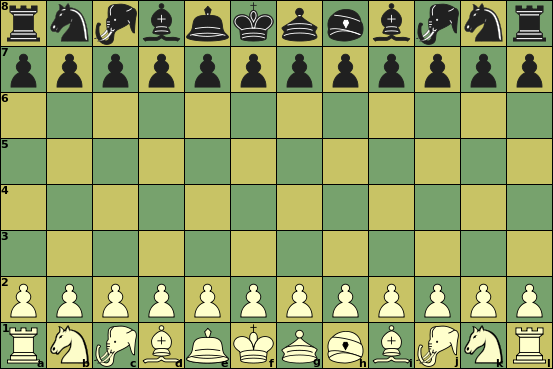Courier Chess (a medieval precursor of modern Chess)
 |
Initial setupf1, f8: King |
Moves at a Glance
Click on a piece below to see its moves
 |
Sliding capture or non-capture, can be blocked on any square along the ray |
||||||||||
 |
Unblockable leap (capture or non-capture) | ||||||||||
 |
 |
Non-capture only | |||||||||
 |
 |
 |
 |
Capture only | |||||||
 |
 |
 |
 |
 |
|||||||
:
:
:
:
| Piece | ID | value | Moves (Betza notation) | Remarks |
| King | K | - | K | No castling of any kind |
| Rook | R | 8 | R | |
| Courier | B | 5 | B | Color bound |
| Elephant | E | 1 | A | Bound to 8 squares! |
| Knight | N | 4 | N | |
| Commoner | M | 4 | K | |
| Ferz | F | 2 | F | Color bound |
| Wazir | W | 1.5 | W | |
| Pawn | P | 1 | mfWcfF | Promotes to Ferz on reaching last rank |
Pawn peculiarities
- Pawns capture differently from how they move (straight move, diagonal capture).
- There is no initial double-push, and thus no en-passant capture.
- Pawns promote to Ferz when they reach last rank; there is no choice.
General rules
- It is not allowed to expose your King to check.
- The game is won by checkmating the opponent's King.
- Stalemate (no legal moves, but not in check) also counts as a loss.
Differences with FIDE
The Commoner (Man) replaces the Queen. The Ferz and Alfil (Elephant) from Shatranj are added, and the board width expanded to accomodate them. The Pawns have no double move. There is no castling.
Strategy issues
It is not possible to force checkmate on a bare King with just a single Bishop or Knight, Ferz or Wazir (in addition to your own King). Two Knights, Ferzes or two Wazirs also cannot do this, and F + W only in rare situations. The Commoner can force checkmate against a bare King.
Alfils are not only color bound, but also skip over half the files and ranks. So they can only reach 8 squares, making them next to worthless.
Bishops are confined to squares of a single color. Having Bishops on both colors compensates this weakness, and is worth an extra 0.5 on top of their added value.